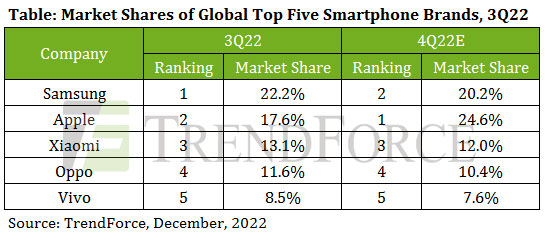News: Markets
8 December 2022
Smartphone production in Q3 down 11% year-on-year
According to market research firm TrendForce, global smartphone production totaled about 289 million units in Q3/2022, down 0.9% quarter-on-quarter and 11% year-on-year. The smartphone market thus saw extremely weak demand as the ‘iron law’ of positive growth in the third quarter was broken after being in effect for years. The contraction of production during this year’s peak season was mainly attributed to smartphone brands giving priority to the consumption of channel inventory for whole devices and maintaining a fairly conservative production plan for Q3/2022. Moreover, they had kept lowering their production targets due to strong global economic headwinds.

Of the major smartphone brands in Q3/2022, Samsung produced about 64.2 million units, up just 3.9% quarter-on-quarter, as a result of the brand scaling back production since Q2/2022 and maintaining a conservative outlook on the future market situation. Due to persistent inventory pressure, Samsung is expected to again post a quarter-on-quarter decline for Q4/2022. Regarding product development, Samsung has been the leader in foldable smartphones. This year, the global market share of foldable smartphones is estimated to reach 1.1% and, within this segment, Samsung is expected to hold a share of almost 90%. As for 2023, the global market share of foldable smartphones is forecasted to climb to 1.5%, with Samsung retaining a share of almost 80% in the segment.
Apple posted 50.8 million units in iPhone production in Q3/2022, showing a stable growth trend. Apple had benefited from the reallocation of the demand that was originally going to Huawei’s smartphones as well as the optimal pricing for the new iPhone models. Furthermore, the third quarter is usually the production ramp-up period as Apple intends to push sales of the new iPhone models to their peak in the fourth quarter. Following the release of the iPhone 14 series, much of the demand for the new iPhone models has been tilted towards the Pro subseries. Accordingly, Apple has also adjusted the share distribution of the different new models in iPhone production.
However, Foxconn’s EMS base in the Chinese city of Zhengzhou has recently experienced a drop in capacity utilization rate due to a local COVID-19 outbreak. Since the base is also Apple’s main site for manufacturing the iPhone Pro models, this incident will impact total iPhone production in Q4/2022.
The ranking of the top five global smartphone brands by production for Q3/2022 is rounded out by Xiaomi, OPPO and Vivo at third, fourth and fifth, respectively. Xiaomi encompasses its sub-brands Redmi, POCO and Black Shark; OPPO includes Realme and OnePlus; and Vivo also takes account of iQoo. Among them, only Xiaomi maintained about the same device production volume compared with the previous quarter, whereas the other two recorded a quarter-on-quarter drop. All of them have been constrained in raising production during the second half of this year due to the pressure to correct excess inventory. They also have to deal with COVID-19 lockdowns in the home market and the recent deceleration of India’s economic growth. Moving into Q4/2022, these three Chinese brands are expected to post mostly flat growth in device production.
Looking further ahead, Xiaomi, OPPO and Vivo will face significant challenges, says TrendForce. First, China, as their home and primary market, is already highly saturated. The enforcement of the zero-COVID policy by the Chinese government has further caused a freeze in domestic demand during the recent period. At the same time, Honor has emerged to pose a direct threat in the competition for domestic market share. To maintain growth, Xiaomi, OPPO and Vivo will have to concentrate on overseas expansion while retaining their domestic market shares.
To escape fallout from US-China dispute, Chinese smartphone brands will support strengthening of domestic supply chain by developing their own chips
To maintain a loyal group of customers and provide effective market positioning for their high-end device models, Samsung, Apple and Huawei have been self-developing chips such as mobile systems-on-a-chip (SOCs). Also, because these three brands have been able to generate additional values with in-house components, the other major Chinese brands are now following their footsteps and are committed to maintaining teams dedicated to chip design.
Xiaomi, for example, has developed the mobile SoC Pengpai S1, the image processing chip Pengpai C1, and the 120W fast-charging chip Pengpai P1. OPPO, too, has unveiled a discrete image signal processor (ISP) named MariSilicon X and is expected to introduce an in-house application processor (AP) in Q1/2024. As for Vivo, it has launched the V1 and V2 chipsets as solutions for optimizing the image processing algorithm of the smartphone camera. Looking at these examples, TrendForce believes that, while Chinese brands are using in-house chips to raise their profiles, their more important aim is to strengthen the domestic supply chain as China and the USA are now locked in an escalating geopolitical competition.
Regarding the state of the smartphone market in Q4/2022, the results from the recent promotional events related to China’s Singles’ Day reveal that smartphone brands have not been particularly effective in spurring device sales by lowering prices. Consumer confidence on the whole has been heavily impacted by various economic headwinds. TrendForce estimates that global smartphone production will total about 316 million units for Q4/2022, translating to a quarter-on-quarter growth of 9.3%. A year-on-year comparison will still show a decline.
TrendForce points out that the smartphone market started to show signs of weakening in Q3/2021. Since then, it has recorded six straight quarters of year-on-year decline in device production. Demand will eventually return when the correction of channel inventory is mostly completed, but this turnaround is expected to occur no earlier than Q2/2023, reckons the firm.
Smartphone production falls 6% in Q2 to 292 million
Smartphone production volume falls 12.8% to 310 million in Q1 due to amplified off-season effect
Q4 smartphone production sees 9.5% quarter-on-quarter growth, driven by 66% growth for Apple
Smartphone production grows just 5.7% in Q3 due to supply chain-related component shortages









